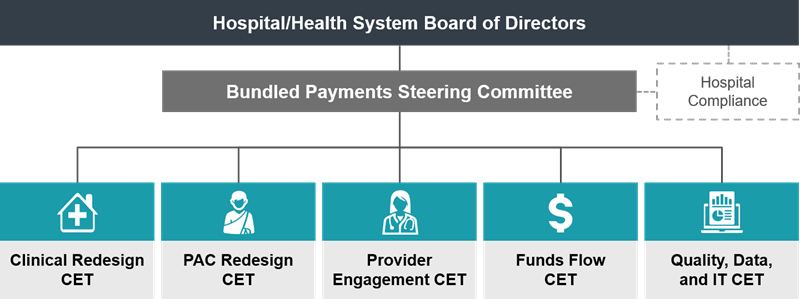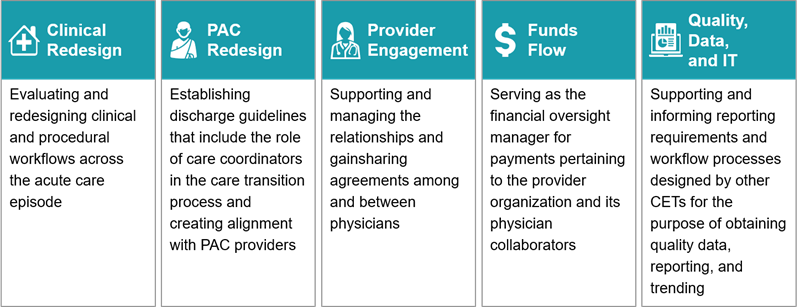
The first performance period for the CMS Bundled Payments for Care Improvement Advanced (BPCI-A) program began on October 1, 2018. Prior to this, organizations participating in the program likely focused their efforts on analyzing data from CMS, selecting episodes, evaluating strategic implications, and completing their applications. Now with the program having started, if you are a BPCI-A participant, you may be wondering how you can operationalize your bundled payment initiatives to position your organization for success.
It is expected that most of the efforts for organizations in BPCI-A will focus on clinical care redesign both in the acute and post-acute settings. Given the breadth and scope of clinical episodes available through BPCI-A (as well as many other commercial bundled payments programs), your organization should focus on facilitating coordination and collaboration among key stakeholders that are helping to implement various clinical care redesign initiatives.
Clinical Effectiveness Team Structure
A “clinical effectiveness team” (CET) structure that is functionally oriented and focused on the major bundled payments program components creates an effective framework for your organization to align strategies, achieve efficiencies, and ultimately succeed under bundled payments. There should be clear lines of accountability, responsibility, and authority in a bundled payment governance structure. Leadership support from all levels of your organization is vital to program success. Each CET reports to a Bundled Payments Steering Committee, which is accountable to the hospital/health system Board of Directors. Hospital compliance also has a role in providing guidance on gainsharing agreements and contracts with post-acute care (PAC) providers. We have depicted a CET reporting and governance structure in figure 1 below.

Key Elements of the CET Structure
Each CET has its own set of objectives that would generally apply to most organizations, as described in figure 2. The short- and long-term priorities of each CET, however, may vary by organization based on bundle selection, available resources, and organizational dynamics.

Each of these teams should be co-led by both a clinical representative and an administrative representative. The clinical co-lead helps ensure physician buy-in and alignment, which is critical to success under bundled payments. The administrative co-lead will be adept at securing, deploying, and managing the resources needed to operationalize the targeted efforts of each CET.
While each CET has its own objectives and responsibilities, significant overlap exists, so coordination and collaboration among the CETs is essential. The Bundled Payments Steering Committee can help support and guide CET collaboration and provide oversight to the CETs, ensuring their efforts are aligned.
Considerations to Keep in Mind When Deploying a CET Structure
- When deploying a CET structure, a communication plan should be created to inform relevant stakeholders about programmatic requirements, key initiatives, and projected changes.
- Reporting can help ensure accountability among and between the CETs. To do so, determine which program performance metrics are readily available, which need to be developed, and which require system integration. Identify a desired results-reporting mechanism (e.g., a dashboard) and publication frequency. Do not forget to schedule ongoing CET meetings for maintenance, monitoring, and updates.
- The CET model is scalable. As additional clinical episodes are added to your organization’s bundled payments program, efficiencies can be gained with select CETs, including Funds Flow, PAC Redesign, and Quality, Data, & IT. These three CETs can support all clinical episodes, as evident through these examples:
- Once the Funds Flow CET implements a gainsharing agreement for one episode or service line, that agreement can form the basis for gainsharing agreements for any additional bundles or service lines subsequently added to the bundled payments program
- The PAC Redesign CET will be working with a limited network of PAC providers in a given market and therefore can collaborate with this network on one bundle or multiple bundles.
- Quality, Data, and IT may develop a dashboard for one bundle initially, but this dashboard could be adopted to serve other bundles in the future.
- The CET framework can be applied as your organization’s bundled payments program and strategy extends across a healthcare system with participation from multiple hospitals. In this case, each hospital in the system would have representatives on the Bunded Payments Steering Committee and CETs.
Regardless of the size of your organization participating in a bundled payment initiative, a CET structure is an effective means for dividing program responsibilities, assuring accountability, coordinating among functional areas—and, ultimately, achieving success under bundled payments.


